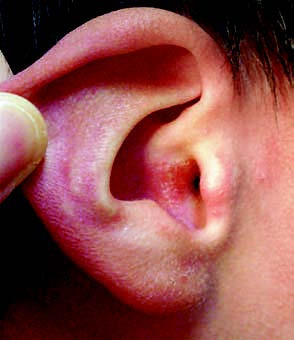Eczema of the external ear is an allergic inflammatory condition affecting the auricle, external auditory canal, and surrounding skin.
Etiology
Eczema of the external ear may be associated with hypersensitivity reactions, psychological factors, or neurological dysfunction. Potential allergens include medications, humid and warm environments, woolen fabrics, cosmetics, hair sprays, and certain foods such as fish, shrimp, and milk. Chronic discharge from the external auditory canal can also act as a trigger.
Clinical Manifestations
Acute eczema is characterized by intense pruritus and burning sensation, mostly in infants and young children. The affected skin may present with erythema or miliary papules, which can progress to form small vesicles. When these vesicles rupture, they release yellowish, watery discharge, leading to epidermal erosion, sometimes covered by yellow crusts. Secondary infection due to scratches may result in expanded lesions, increased exudation, and the development of small, shallow ulcers.
Chronic eczema, in addition to pruritus, causes thickening of the external ear skin, scaling, cracking, crusting, and localized hyperpigmentation. The surface becomes rough and uneven, which may lead to narrowing of the external auditory canal. In cases where the tympanic membrane is involved, mild conductive hearing loss and tinnitus may occur.

Figure 1 Eczema of the external ear
Treatment
The causative factors should be identified and removed, and exposure to allergens should be avoided.
Soap or hot water should be avoided to clean the affected area, and the irritating medications are contraindicated. Scratches, ear picking, and other mechanical irritations should be avoided.
For cases with significant exudation, wet compresses with 3% boric acid solution or 15% zinc oxide solution may be applied. For cases with minimal or no exudation, topical 1% - 2% gentian violet solution, corticosteroid-based cold creams or ointments, zinc oxide oil, or pastes may be used. If crusts are present, they can be cleaned with 3% hydrogen peroxide solution, and then treated with the aforementioned medications.
Chronic eczema with skin thickening or cracking may be treated with 10% - 15% silver nitrate. During remission periods, the external auditory canal can be cleaned with 70% ethanol solution to maintain dryness.
Systemic treatment may involve the use of antihistamines such as chlorpheniramine and loratadine. Severe cases may require glucocorticoids like dexamethasone. Secondary infections can be managed with local or systemic antibiotics. In case of significant exudation, fluid replacement and vitamin C supplementation may be necessary.